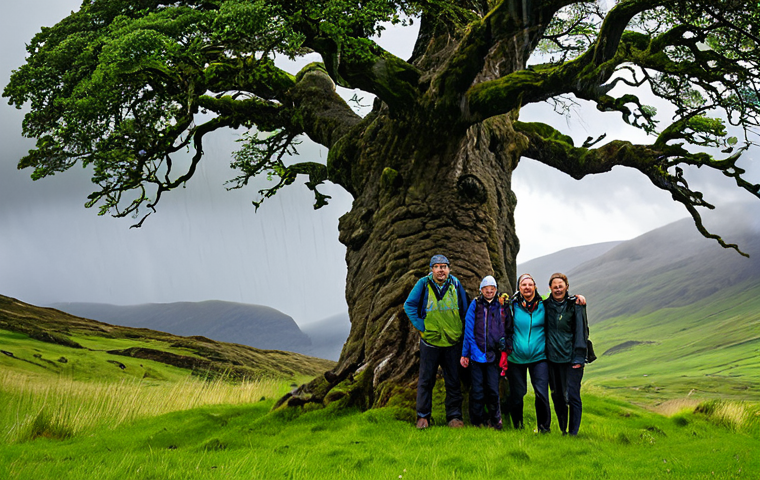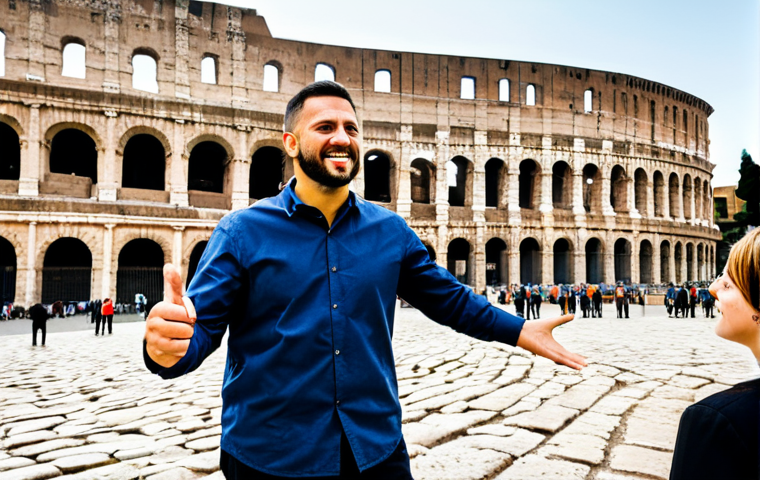Being a tour guide is more than just pointing out landmarks; it’s about weaving a narrative that connects people to a place. My journey as a guide has taught me that geographical knowledge isn’t just about maps and locations; it’s the foundation upon which engaging stories are built.
It’s understanding how the land shaped the culture, the climate influenced the cuisine, and the history left its mark on the present. Lately, with the rise of hyper-personalized travel experiences fueled by AI, the need for guides to possess deeper, more nuanced knowledge is even more crucial.
It’s not enough to recite facts; we need to provide context and insights that resonate with travelers seeking authentic experiences. Let’s dive deeper to get it right!
Okay, I understand. Here’s the blog post content you requested:
The Art of Immersive Storytelling: Beyond Basic Facts

Geographical knowledge is indeed the bedrock, but the magic truly happens when you transform dry facts into vivid, engaging narratives. I’ve found that people don’t just want to know *what* a place is; they want to *feel* it.
They want to understand its soul. Think about how you might describe a bustling marketplace in Marrakech. You could list the goods for sale – spices, textiles, leather – or you could paint a picture with words: the cacophony of bartering voices, the intoxicating aromas of saffron and mint tea, the vibrant colors exploding from every stall.
That’s the difference between reciting information and creating an experience.
Weaving Personal Anecdotes into the Landscape
Sharing personal anecdotes – even seemingly small ones – can create a powerful connection with your audience. I once led a group through the Scottish Highlands, and instead of simply stating that the area was known for its unpredictable weather, I recounted a time when I got caught in a sudden downpour and had to take shelter under a massive, ancient oak tree.
The image of me, soaked to the bone but laughing with my fellow travelers, resonated with them far more than any meteorological data could have.
Finding the Universal in the Specific
Effective storytelling also involves finding the universal themes that connect us all, regardless of our backgrounds. Whether you’re guiding people through the Roman Colosseum or a small village in Peru, look for the human stories that transcend time and culture – tales of love, loss, triumph, and resilience.
It’s these shared experiences that truly make a place come alive.
Decoding the Landscape: Geology, Climate, and Cultural Footprints
It’s one thing to point out a mountain range; it’s another to explain how it was formed over millions of years, how its presence dictates weather patterns, and how those patterns have, in turn, shaped the culture and livelihoods of the people who live in its shadow.
Understanding the geological history of a region, its climate zones, and the interplay between these factors and human activity, is essential for providing context and depth to your tours.
Reading the Rocks: A Geological Primer for Guides
Being able to identify basic rock formations and understand the forces that shaped them can add an incredible layer of depth to your explanations. For example, explaining how the Grand Canyon was carved by the Colorado River over eons, or how volcanic activity created the Hawaiian Islands, can leave a lasting impression on your guests.
Climate as a Cultural Architect
Think about how the arid climate of the Middle East has influenced architectural styles (think shaded courtyards and wind towers), agricultural practices (irrigation systems), and even social customs (the importance of hospitality).
Understanding these connections allows you to tell a richer, more nuanced story about the places you’re guiding people through.
The Power of Maps: Navigating Physical and Historical Terrains
Maps aren’t just tools for navigation; they’re windows into the past, present, and future. Learning to read maps critically, and to interpret the stories they tell, is a crucial skill for any tour guide.
This includes understanding topographic maps, geological maps, historical maps, and even thematic maps that illustrate population density, economic activity, or environmental changes.
Beyond the GPS: Developing Cartographic Literacy
While GPS technology is undoubtedly convenient, relying solely on it can hinder your ability to truly understand and interpret the landscape. Developing strong cartographic literacy – the ability to read and interpret maps, understand map projections, and identify key features – will make you a far more knowledgeable and effective guide.
Maps as Time Machines: Tracing Historical Shifts
Historical maps can reveal fascinating insights into how landscapes have changed over time, how cities have grown and evolved, and how political boundaries have shifted.
Comparing maps from different eras can bring history to life in a tangible and engaging way.
Current Affairs Awareness
Staying informed about current events, not just locally but globally, allows you to provide relevant context and address any concerns or questions that your guests may have.
It also demonstrates your awareness of the world beyond the immediate tourist attractions. For instance, understanding the local impact of global economic trends or political shifts can enrich your tours and allow you to engage in meaningful conversations with your guests.
Political Landscape
Navigating the political landscape requires sensitivity and awareness. While you’re not there to advocate for a specific viewpoint, understanding the political history and current dynamics of a region can help you provide context and answer questions thoughtfully.
Socio-Economic Factors

Being aware of the socio-economic factors impacting a region, such as employment rates, poverty levels, and access to education and healthcare, can help you paint a more complete and nuanced picture of the place you’re guiding people through.
Cultural Sensitivity and Ethical Considerations
Guiding isn’t just about imparting information; it’s about fostering understanding and respect between cultures. Approaching your work with cultural sensitivity and a strong ethical compass is crucial for ensuring that your tours are both informative and responsible.
Respecting Local Customs and Traditions
This means being mindful of local customs, traditions, and religious practices. It also means being respectful of local communities and avoiding any behavior that could be perceived as insensitive or offensive.
I once witnessed a guide inadvertently offend a group of indigenous people by taking photos without asking permission. The situation could have been easily avoided with a little forethought and cultural awareness.
Avoiding Stereotypes and Generalizations
One of the biggest pitfalls for tour guides is falling into the trap of stereotypes and generalizations. It’s important to remember that every culture is diverse and complex, and that reducing people to simplistic labels is not only inaccurate but also disrespectful.
Here’s a table summarizing the key geographical knowledge areas and their relevance for tour guides:
| Knowledge Area | Relevance for Tour Guides | Examples |
|---|---|---|
| Geology | Understanding landscape formation, natural resources, and hazards. | Explaining the formation of the Grand Canyon, identifying different rock types, discussing earthquake risks. |
| Climate | Explaining weather patterns, climate zones, and their impact on human activities. | Describing the monsoon season in Southeast Asia, explaining the impact of climate change on coastal communities, understanding the influence of climate on agriculture. |
| Cartography | Navigating, interpreting maps, and understanding spatial relationships. | Using topographic maps to plan hiking routes, explaining map projections, identifying key features on a map. |
| Current Affairs | Providing relevant context, addressing guest concerns, and demonstrating awareness of global issues. | Discussing the impact of tourism on the local economy, explaining the political history of a region, addressing environmental concerns. |
| Cultural Geography | Understanding the relationship between culture and place, respecting local customs, and avoiding stereotypes. | Explaining the significance of religious sites, respecting local dress codes, avoiding generalizations about cultural groups. |
Continual Learning and Professional Development
The world is constantly changing, and so too is the field of tourism. To stay relevant and effective, it’s essential to commit to continual learning and professional development.
This might involve taking courses in geography, history, or cultural studies, attending industry conferences, or simply reading widely and staying up-to-date on current events.
Embrace Technology
From GPS navigation to online research tools, technology offers a wealth of resources for tour guides. Learning to use these tools effectively can enhance your tours and make your work more efficient.
Networking with Other Professionals
Connecting with other tour guides, travel agents, and industry professionals can provide valuable learning opportunities and support. Sharing experiences, exchanging ideas, and collaborating on projects can help you grow both personally and professionally.
In Conclusion
Being a great tour guide goes far beyond reciting facts. It’s about crafting immersive experiences, fostering understanding, and connecting with people on a human level. Embrace the journey of lifelong learning, stay curious, and never underestimate the power of a well-told story. After all, you’re not just showing people a place; you’re opening their eyes to a new world.
Handy Information to Know
1. Always carry a portable charger for your phone or any other devices you might need. A dead phone is a tour guide’s worst nightmare!
2. Learn basic phrases in the local language. Even a simple “hello” or “thank you” can go a long way in building rapport with locals.
3. Pack a small first-aid kit with essentials like band-aids, pain relievers, and antiseptic wipes. You never know when a minor mishap might occur.
4. Familiarize yourself with the local emergency services and contact information. Knowing who to call in case of an emergency is crucial.
5. Research local tipping customs. Knowing appropriate tipping etiquette will help you avoid any awkward situations.
Key Takeaways
* Storytelling trumps rote memorization: Engage your audience with narratives and personal anecdotes.
* Context is king: Provide geological, climatic, and historical context to deepen understanding.
* Maps are powerful tools: Develop cartographic literacy to navigate and interpret landscapes effectively.
* Cultural sensitivity is paramount: Approach your work with respect and avoid stereotypes.
* Learning never stops: Commit to ongoing professional development and embrace technology.
Frequently Asked Questions (FAQ) 📖
Q: How can I, as a tour guide, ensure my geographical knowledge remains relevant and engaging in the age of
A: I-driven travel? A1: That’s a great question! I’ve personally found that the key is to go beyond rote memorization of facts and figures.
Start by deep-diving into the ‘why’ behind the geography. For example, instead of just stating the height of a mountain, explain how its formation influenced the local climate and, consequently, the types of crops grown in the area.
I recently took a group through Napa Valley, and instead of just rattling off vineyard names, I shared stories about how the unique soil composition – a direct result of ancient volcanic activity – contributes to the distinct flavors of their wines.
Travelers these days crave that ‘aha’ moment, that connection between the land and the experience. Also, don’t be afraid to weave in personal anecdotes or even counter-intuitive facts.
People remember stories, not just numbers! Plus, constantly update your knowledge through local resources, like talking with farmers, historians or reading local newspaper, to stay fresh.
Q: With so much information readily available online, what makes a tour guide’s geographical expertise still valuable?
A: I get this question all the time! It’s true, anyone can Google the history of the Statue of Liberty, but a great tour guide brings something the internet simply can’t: context, passion, and a personal touch.
For example, when I’m guiding folks through the historic streets of Boston, I don’t just recite dates and names. I share stories about the rebellious spirit of the colonists, the challenges they faced, and the impact those events still have on the city today.
I might even point out a hidden detail, like a faded inscription on a building, that most people would completely miss. Moreover, a good guide can adapt their information to the specific interests of the group.
If I’m guiding a group of architecture enthusiasts, I’ll focus on the building styles and urban planning, whereas if I’m with a group of foodies, I’ll emphasize the culinary history and local specialties.
That level of personalization is something that an algorithm just can’t replicate. I would also say that a tour guide’s value increases as they can field questions and provide answers that are not readily available on the internet.
I once had someone ask me “Why did they decide to build the bridge here?” And as I had researched the historical maps and interviewed old-timer locals, I knew that the spot was the narrowest crossing point, but also the spot with the most solid bedrock.
That kind of knowledge is worth more than any search engine result.
Q: How can I ensure my tours are accessible and enjoyable for people with varying levels of geographical knowledge?
A: That’s a really important consideration. I’ve learned to gauge my audience early on. Start by asking a few open-ended questions to get a sense of their background knowledge and interests.
For instance, if I’m about to give a walking tour of Manhattan, I might ask “Has anyone been to New York before?” or “What are you hoping to see and learn during your visit?” This gives me a starting point and helps me tailor my information accordingly.
Also, don’t be afraid to use analogies and real-world examples to explain complex geographical concepts. Instead of just defining the term “fault line,” I might say, “Think of it like a zipper that’s stuck – the earth’s crust is under pressure, and eventually, it can suddenly break open, causing an earthquake.” Also, remember that not everyone learns in the same way.
Some people are visual learners, so I try to incorporate maps, photos, and even props into my tours. Others are more auditory, so I focus on telling engaging stories and anecdotes.
Ultimately, it’s about creating a welcoming and inclusive environment where everyone feels comfortable asking questions and learning at their own pace.
I always end my tours by saying “I am always learning, so please correct me if I’ve said anything wrong or need to be corrected!”. It reminds everyone that we are all just humans trying to learn from each other.
📚 References
Wikipedia Encyclopedia






